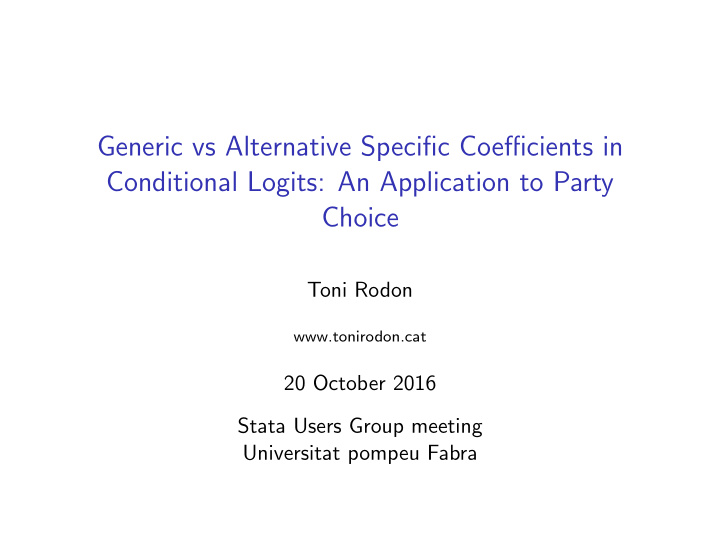



Generic vs Alternative Specific Coefficients in Conditional Logits: An Application to Party Choice Toni Rodon www.tonirodon.cat 20 October 2016 Stata Users Group meeting Universitat pompeu Fabra
Motivation Car Bus Train ◮ Decision-maker (individual), alternatives, attributes, decision rule (utility theory).
Conditional logit Supose a discrete choice among J alternatives. Then the Utility of the j-th choice to the i-th individual will be: U ij = � k k =1 α k | x ik − p ijk | U ij = V ij + ǫ ij P ij = P ( V ij − V ih > ǫ ih − ǫ ij ) , ∀ h � = j
Conditional logit exp ( V ij ) P ij = � J h =1 exp ( V ih ) V ij = β j 0 + s T i β j + z T ij α
Conditional logit V ij = β j 0 + s T i β j + z T ij α ◮ With regard to individual characteristics, the corresponding coefficients β j indicate varying segment-specific evaluations of alternatives. ◮ z ij the related coefficient α has not alternative-specific subscript.
Generic or alternative-specific parameters ◮ Difference between fixed or generic and alternative-specific issue distance parameters. ◮ Assume that V ij consists of the following components: (1) a base utility of a party j , constituted by the alternative specific constant β j 0 (2) the individual-specific evaluation of candidate j (i.e. voter’s evaluation of party jth leader) represented by β j Candidate i (3) the perceived issue distance between voter i and party j represented by α IssueDistance ij V ij = β j 0 + β j Candidate i + α IssueDistance ij
Generic or alternative-specific parameters ◮ ‘splitting’ the generic parameter into so-called alternative-specific parameters. ◮ specifying for each party a specific partial utility function for each kth issue, and therefore by estimating for each party–issue–distance combination a separate parameter ◮ Parties: PP (P); PSOE (S); Podemos (M), C’s (C) V iP = α C IssueDistance ic , V iS = β so + β sCandidate i + α S IssueDistance is , V iM = β mo + β mCandidate i + α m IssueDistance im , V iC = β co + β cCandidate i + α c IssueDistance ic ,
Generic or alternative-specific parameters ◮ H 0 There are no party-specific issue effects, implying that issues are identically valuated with regard to all parties.
Empirical test ◮ Astudillo, J and Toni Rodon (2013) El comportamiento electoral del votante en la mediana y las “paradojas” de la competici´ on pol´ ıtica espanola . Revista Espanola de Investigaciones Sociol´ ogicas, 144: 3-21.
Empirics ◮ The nationalization of EU politics versus the Europeanization of national politics. Party supply and EU voting in Germany, Italy and Spain (with Mariano Torcal) ◮ EU does not matter when voting in EU elections. ◮ We argue this depends on the degree of Europeanization, based on the pivotal role the country plays in Europe. ◮ First stage: presence of anti-EU parties. ◮ Second stage: the pivotal role is internalized among citizens and drives voting patterns across the board. ◮ *EU elections are of second-order, so the traditional LR dimension will still be more relevant.
Empirical analysis ◮ Spain, Italy and Germany (panel surveys). ◮ Left-right scale, EU integration scale. ◮ Controls (party identification, gender, income, leadership evaluation...)
Empirical analysis
Empirical analysis gen asc_spd = (party==2) gen asc_linke = (party==3) gen asc_grunen = (party==4) gen asc_afd = (party==5) foreach i in zdist_ideol { gen ‘i’_cdu = ‘i’ * (party==1) gen ‘i’_spd = ‘i’ * (party==2) gen ‘i’_linke = ‘i’ * (party==3) gen ‘i’_grunen = ‘i’ * (party==4) gen ‘i’_afd = ‘i’ * (party==5) }
Empirical analysis
Results - Spain
Results - Italy
Results - Italy (generic)
Results - Germany
Conclusions ◮ Not all parties are equally effective and successful in attracting electoral responsiveness on the same issues. ◮ Issue voting substantially varies across parties. ◮ We need to statistically identify such party-varying issue reactions within the established paradigm of the Spatial Theory of Voting. ◮ We showed the validity of this approach using the EU elections as an example.
Next steps ◮ Endogeneity! ◮ Link demand and party supply. ◮ Extend it to other contexts.
Generic vs Alternative Specific Coefficients in Conditional Logits: An Application to Party Choice Toni Rodon www.tonirodon.cat 20 October 2016 Stata Users Group meeting Universitat pompeu Fabra
Recommend
More recommend